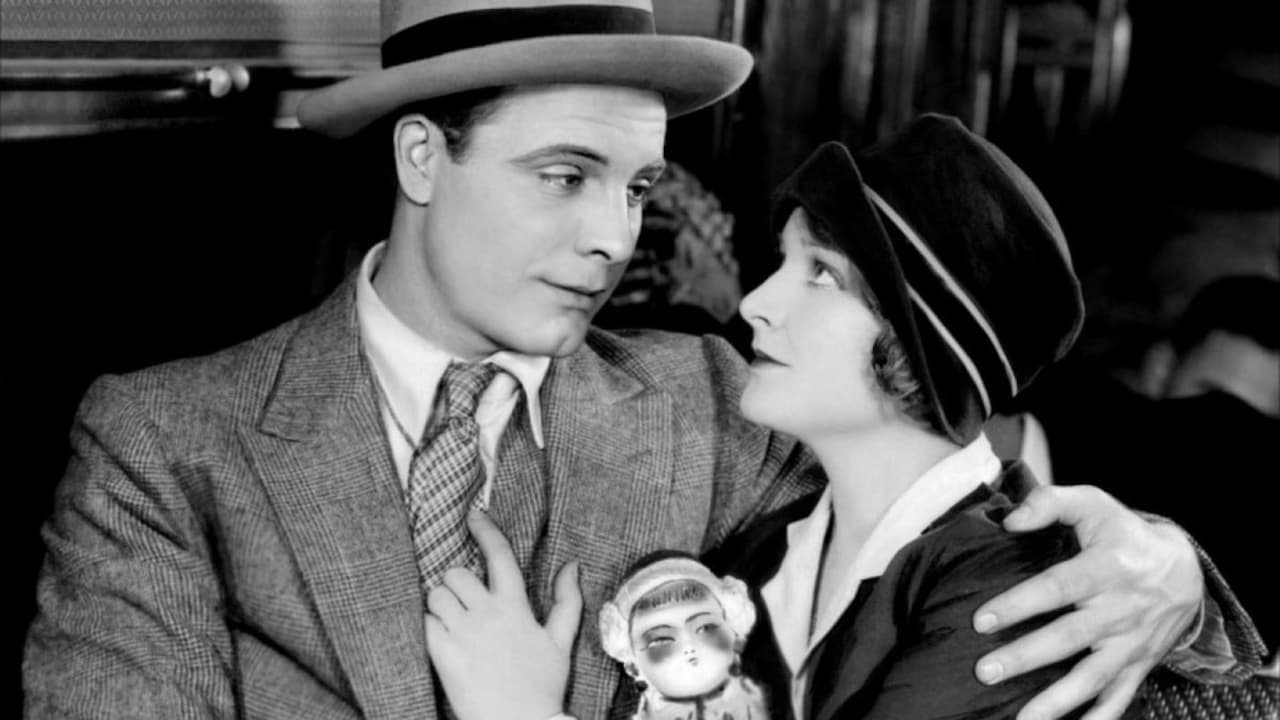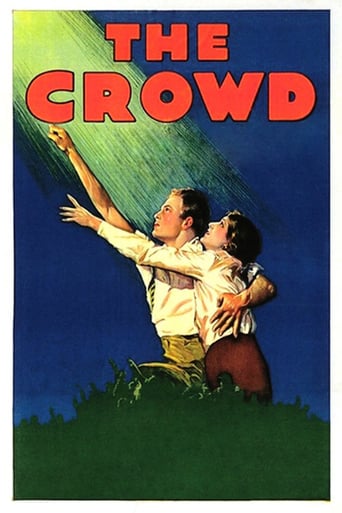

John (James Murray) and Mary (Eleanor Boardman - Mrs Vidor) are two, faces in the crowd. They meet, they get married, they have children. A common story. But in the cinema, nothing is common.We are more interested in John. He is a good little boy full of promises. He will become someone important. Unless Unless his father dies, which happens when he is 12. Now we switch the figures. John is 21. He lands in New York convinced he is different and will tame this city. Meanwhile, he works as an accountant in an insurance company. But he studies at night, to become – still – someone important. One evening, his friend Bert (Bert Roach) invites him to Coney Island with two girls. At first, he refuses but in the end, he accepts. There, he meets Mary. They kiss in the Tunnel of Love. They are soon to get married. Despite Bert's pessimism, their marriage lasts. They have two kids. One day, John has a brilliant idea for an advertisement. He gets 500 dollars. He calls his children to celebrate this great moment. This is when Fate intervenes: their little girl gets run over by a car. Misfortunes will multiply, and John will have to fight the Crowd of those who did not want to be different.This film by King Vidor is not what we call a joyful film. It is very different from what the MG was offering to the movie audiences. Showing normal people was not a very good marketing product. It was not well accepted to show ordinary people and a sad ending. Therefore, Vidor held on and this ending is one of the nine endings which were shot. This is the least sad ending (the least bad ending?): John does not reach his goal. He will never be someone important. Just a face in the crowd, among many (many, many ) others. This is why the film is very interesting. We can see a quick romance. Quick, because the whole society demands it. everything goes fast: cars, trains and people going to work. Therefore, people have very little time for themselves, or to build something. The crowd is a huge wave which overwhelms everything. The peak hours are a moment which show this very well. When the clock strikes the end of the day's work, you can see crowds of people rushing to the elevators or the undergrounds alone or as couples. But John just want one thing: being different. He feels superior to the others. He thinks he has a mission, a great purpose. And this feeling starts irritating the others. He even mocks the poor guys who have to juggle to make (a bit of) a living, advertising for a restaurant. But would he have mock them if he had known that one day, he would have to do the same thing? As soon as John enters New York, things are different. Vidor picks up a building, the camera travels from bottom to the top, stops in front of a window, and then enters: desks, desks, desks... Hundreds of them! So he goes on, forward, to one desk: John Sim, 137. And he takes this man - a face in this desk crowd - and brings him to the light. We are going to learn everything which makes him a man: his life, his dreams, his wife, his kids, his (step) family... And his misfortunes! (Vidor will recall the emotion of the little girl's death in another movie - Hallelujah - when another child dies) Even if this child brings him his misfortune, the other brings him anew hope: he is completely desperate, on the brink of suicide when he realizes that his other child LOVES him. His son wishes to become like him! This was what he needed. Now we know he will get better and better. But to get better, he will have to accept to be just a member of the society like anyone else, and therefore be just a face in the crowd. And he accepts it. The story is over. The camera goes backwards revealing us the crowd of people around him, again and again, till he disappears in this overwhelming crowd. Vidor has put him back where he originally belonged.
... View MoreThanks to Turner Classic Movies, for the first time in my long film viewing life I have learned to appreciate silent movies, at least the best of them, and I believe that "The Crowd" stands very tall among this group.The story of John (James Murray) and Mary (Eleanor Boardman) Sims in 1928 could easily be the timeless story of a struggling couple in any major American city today, including their hopes, dreams, celebrations, and, alas, calamities. As a working stiff for over 40 years, some of them occurring in the very cold, impersonal cities of New York, Boston, and Washington, I could very much relate to the struggles of the Sims, thanks mostly to the very effective direction of King Vidor and the excellent dramatic efforts of Murray and Boardman. In addition, Bert (Bert Roach), as the jovial, successful, and socially adept colleague of John, literally bounced off the screen as someone who could have realistically been one of my own co-workers during this century.What I value most about this film is Vidor's ability to contrast the impersonal, dispassionate, and often cruel world of the big city and its large organizations against the very human, emotional story of one, single family living somewhere within the endless surge of the multitudes. The film also allows us a rare glimpse of New York City life almost 90 years ago. For ninety minutes, I felt as though I were right there, battling the world as my parents and grandparents did during those times, which, in so many ways, are not very different from our own era today as we still struggle to attain the good life.I only wish that John did not recklessly lure his kids from across the busy street by holding the toys out of the apartment window, but that was John. What irked me even more was that after misfortune strikes the family, the parents failed to watch Junior as closely as they should have. Hadn't they learned by then? I was saddened to read of the tragic, true life of James Murray. For me, it made the tribulations of the fictional John Sims even more sorrowful.
... View MoreAfter hearing and seeing so many references to the genius of Vidor's "The Crowd", I was anxious to appreciate all it's glory.Not a disappointment, he cleverly utilizes Ninja camera tactics unparalleled in it's time and for many years to come. I found it fascinating that NYC even then, was so extremely crowded and the traffic horrific with both horse and automobile competing for lanes. The traffic cop was a very busy and quite agitated man, yielding no stop signs or lights, but yet averts complete chaos. Portraying Mr. Sims as smug, privileged and above everyone else, we quickly realize he is obviously delusional. This trait was never more aptly portrayed at the family get together on Coney Island Beach. He sings joyfully how he is all alone, strumming his ukulele (zither??) while Mother builds a fire, cooks bacon and protects a frosted cake (!) while the children run amok. What happened to the typical simple picnic of sandwiches and cookies in the middle of all that sand? It was a noxious scene but alluded to Sim's total lack of responsibility and shirking of family duties.So many dreams and opportunities lost but the ending, uplifting. Be aware the themes tackled here are extremely rare in silent films so try to look for the bright spots.High recommend for the phenomenal glimpse of NYC in the 20's and the raw talent of a handsome extra.
... View MoreKing Vidor has a knack for making stark melodrama seem real enough and this is even evident as early as THE CROWD, where his Depression-era hero (JAMES MURRAY) and his wife (ELEANOR BOARDMAN) struggle to make ends meet during the dark days of a marriage that begins with a sweet romance and almost ends in bitter despair.Murray and Boardman make all of their touching scenes very realistic. He was obviously a natural talent who was discovered by King Vidor for this film and made the most of a meaty role, running the gamut of emotions from joy to sorrow with effortless ease and a certain amount of charm. Boardman too is very effective as the wife who stands by her man even though she realizes he will never rise above "the crowd," the way he always promises he will.Ironically, in real life Murray couldn't handle his overnight success and a few years later was a skid row alcoholic whose life ended when his body was plucked from a river pier in Manhattan. His downward spiral is very similar to the character he plays in this film.While the story has plenty of depressing elements, Vidor's direction keeps it a compelling study of a strained marriage that starts to unravel upon the death of Murray's baby daughter. A highly emotional scene between father and son toward the end--just when the man is on the brink of suicide--is as touching and eloquent as any scene in the film. In some ways, the film mirrors the kind of performance actors in this type of role have to sustain over all the highs and lows--the way James Stewart did so effectively in IT'S A WONDERFUL LIFE. Murray's character is just as demanding and he plays it brilliantly.For a silent film, much of the acting is more restrained than usual, but Vidor does seem to heighten melodramatic moments for maximum effect, as he would later on in films like BEYOND THE FOREST and THE FOUNDTAINHEAD.
... View More